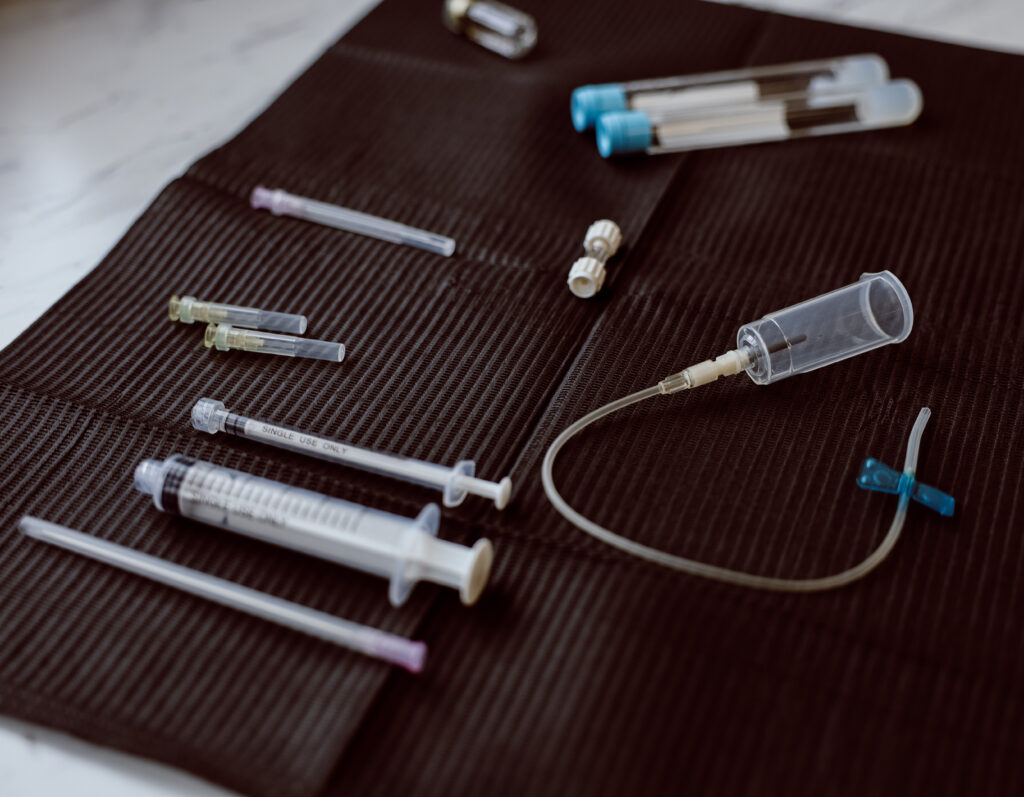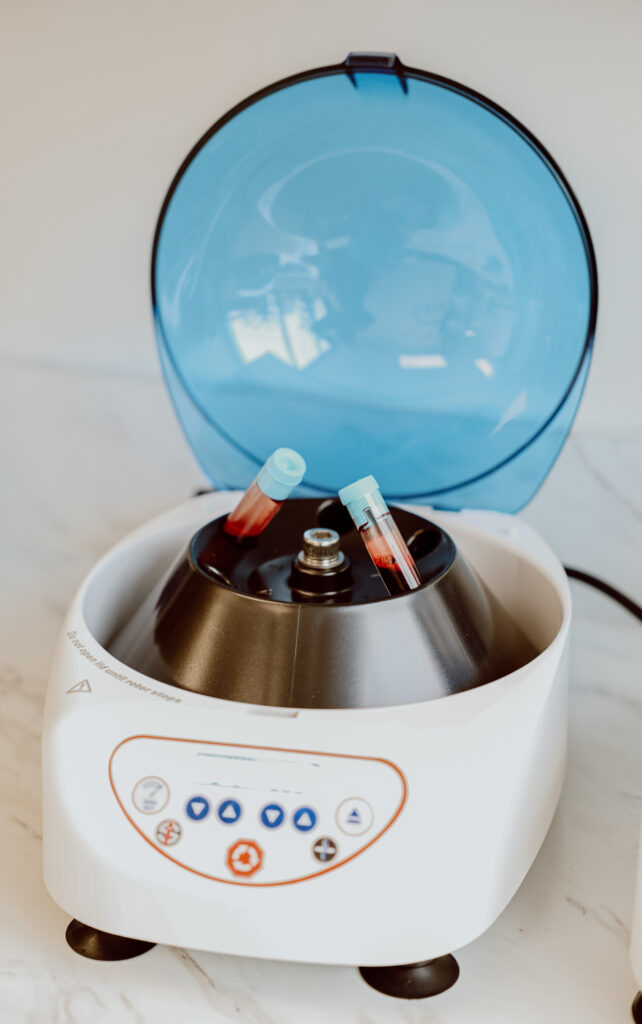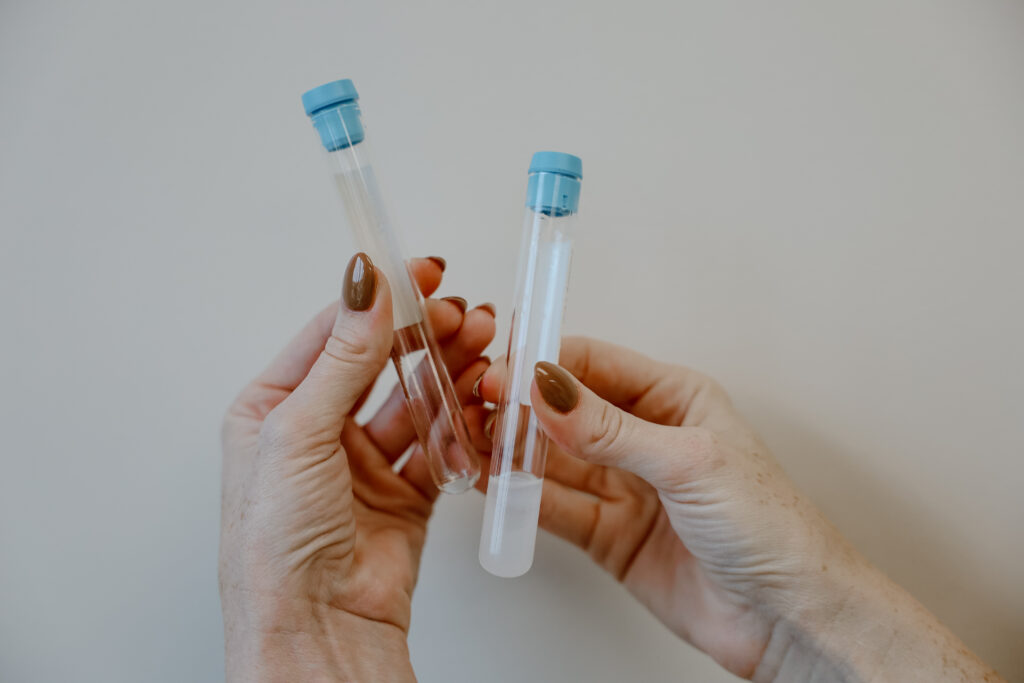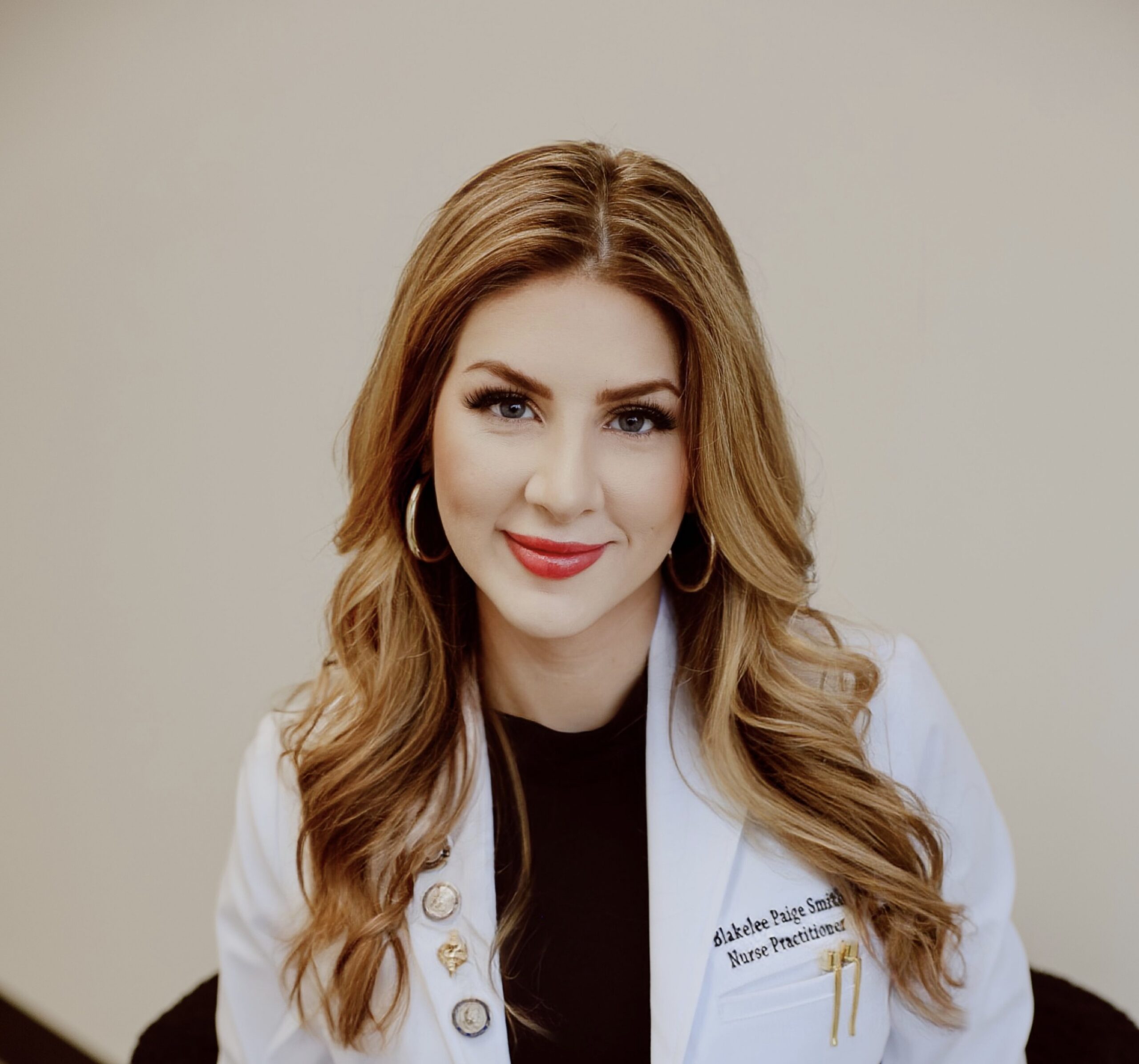A Natural Option: PRP
Acne Scarring, Anti-Aging, Clear Skin, Hair Loss, Injectables, Natural Growth Factors, PRP, Skincare
June 2, 2024
If you’ve been in the clinic for a consultation, we’ve likely discussed PRP, PRF, or both at some point. Both PRP and PRF have gained popularity in aesthetic dermatology and for good reason! These are both options that are considered a natural and minimally-invasive approach to skin rejuvenation. These treatments offer a non-surgical alternative for patients seeking to improve skin texture, reduce wrinkles, and overall tackle the aging process head-on. Additionally, PRP and PRF can also be used in combination with other aesthetic procedures, such as microneedling and laser therapy, to optimize results and accelerate healing.
Most of that is pretty straightforward, but where it gets tricky is trying to understand what PRP is, what PRF is, and even more, what ezGEL PRF is. Platelet-Rich Plasma (PRP) and Platelet-Rich Fibrin (PRF) are autologous (meaning coming from YOU) blood-derived treatments that harness the regenerative properties of your own platelets and growth factors to promote tissue repair and rejuvenation, but there are some key differences. Because Skin + Aesthetics offers all options for patients, I wanted to take the time to go a little more in depth on all three of these options, so today, we will start with the world of PRP!
[As a side note, I know that some providers have mentioned that they reference my blogs and some patients also like going into every detail while others like to keep it surface level. While I’ve aimed this blog post to go somewhat deep into these topics, I’ve ended each question with “The Gist of It” in hopes to make it easier for those that wish to learn but also not dive into all the details. You’re welcome to choose whichever you’re looking for… or both!]
How do you obtain PRP?

Let’s first start the discussion of what PRP is with talking about how it is prepared. In the clinic, I start by drawing a small sample of your blood (typically between 30 to 60 milliliters) from a peripheral vein. This is placed in a PRP tube, which contains an anticoagulant to prevent the blood from clotting in the tube and a separation gel to help isolate the different components of the blood. After we obtain your blood sample, your tube is labeled with your name and taken to a machine called a centrifuge.
The centrifuge is set to specific settings for PRP, which separates the different components of blood based on their densities. This results in blood separated into three layers: red blood cells at the bottom, platelet-poor plasma in the middle, and platelet-rich plasma at the top. After the blood is spun and separated, the layer containing platelet-rich plasma is carefully extracted and further processed to increase the concentration of platelets.
The “further processing” part of this can involve additional centrifugation steps or filtration techniques to isolate the platelet-rich fraction from the rest of the plasma. In some cases, the PRP may be activated using calcium chloride or other substances to release growth factors from the platelets before application. In my clinic, we activate the PRP for certain indications so our patients are getting the most bang for their buck.
The Gist of It: We draw your blood in clinic and spin it down so that it separates into 3 layers– red blood cells, platelet-poor plasma, and platelet-rich plasma.
What are the components?

The primary components of PRP include platelets, growth factors, and other bioactive proteins. This gets a little deep, so I’m going to try to write this as simple as can be without making it too complicated because, honestly, I could go down a whole rabbit hole!
Platelets: Let’s first start with the arguably most important component, as it is in the name PRP itself– platelets! Platelets are small, disc-shaped cell fragments that are present in the blood. They play a crucial role in hemostasis (aka blood clotting), clot formation, inflammation (in a positive way, as they help repair), angiogenesis (aka growing new blood vessels), immune response, and in wound healing. Considering all they do for our body in daily functioning, it is no wonder that we want them in the largest concentration possible!
By spinning down your blood and separating out the components, platelets are concentrated to levels higher than those found in whole blood, typically ranging from 2 to 10 times the baseline concentration. The brand of PRP tubes I’ve chosen in the clinic has been studied widely using the specific centrifuge settings I utilize and concentrates the platelets to about 8-10 times what’s naturally occurring in your body!
Growth Factors: Next up on the list is growth factors! Again, we can go super deep into this as well, but I’m going to try to keep it as broad as possible, while also giving you the information you deserve! Growth factors are a group of proteins that regulate various cellular processes, including cell proliferation, differentiation, migration, and survival. They play critical roles in tissue development, repair, and maintenance, which is the most important part of all of this when looking specifically at anti-aging and rejuvenation.
Types of growth factors include Epidermal Growth Factor (EGF), Fibroblast Growth Factor (FGF), Platelet-Derived Growth Factor (PDGF), Transforming Growth Factor-Beta (TGF-B), Vascular Endothelial Growth Factor (VEGF), Insulin-Like Growth Factor (IGF), and Nerve Growth Factor (NGF). While I could go into what each of these does, unless you’re looking to become a master of PRP, I think I can keep it broad and just simply say these stimulate cell growth, induce cell differentiation promote tissue repair and regeneration, regulate angiogenesis (forming of new blood vessels), regulate inflammation, regulate cell turnover, and promote collagen synthesis.
Other Bioactive Proteins: Last up, I’ve added all the remaining components into the category of “other bioactive proteins”. In addition to platelets and growth factors, PRP also contains various bioactive proteins, cytokines, and chemokines that contribute to its regenerative properties. These proteins help modulate inflammation, recruit stem cells, and facilitate tissue repair processes.
The Gist Of It: PRP includes platelets, growth factors, and other bioactive proteins. Because of the PRP tubes and settings we use, Skin + Aesthetics is able to concentrate your platelets to about 5x what is naturally occurring in your body so you’re able to see benefits like decreased inflammation, collagen synthesis, tissue repair, and healing.
What does PRP treat?

PRP can be used both in medical and aesthetic conditions, making it an incredibly versatile treatment option. In my clinic, we use it for both medical and aesthetic conditions.
Medical Conditions: In the clinic, we use PRP for chronic wounds, some dermatologic conditions, and for some cases of hair loss. In chronic wounds, PRP can help accelerate would healing and in hair loss, PRP has been shown to be a successful treatment in androgenetic alopecia (both male and female pattern baldness) and in some other types of alopecia as well. While I typically will use this in combination with other medical treatments for alopecia, PRP can help stimulate hair follicle growth, prolong the growth phase of hair (anlagen), and increase hair thickness and density.
Additionally, PRP can be used in the orthopedic realm (which I do NOT offer) and may be used to treat musculoskeletal injuries, such as tendonitis, ligament sprains, muscle strains, and osteoarthritis. Another option for PRP (that I also do NOT offer) is in dental procedures, as it used in oral and maxillofacial surgery to promote bone regeneration, accelerate healing, and enhance the success of dental implant procedures, bone grafts, and periodontal surgeries.
Dermatologic and Aesthetic Conditions: PRP is an excellent option for rejuvenation of the face, neck, and décolletage. Not only can these injections improve skin texture, reduce fine lines and wrinkles, enhance skin hydration and elasticity, and restore a youthful appearance, but they also can help improve the appearance of acne and other types of scars by stimulating collagen production, promoting tissue remodeling, and smoothing out uneven skin texture.
Depending on the individual candidate and numerous factors we typically break down in your initial consultation, PRP injections may also be able to reduce the appearance of dark circles and under-eye bags by stimulating collagen production, improving skin texture, and promoting blood circulation in the periorbital area in some specific candidates.
PRP can also be combined with dermal fillers or used alone to restore volume loss in areas such as the cheeks, temples, under eyes, and hands. Because PRP promotes collagen synthesis and tissue regeneration, this leads to natural-looking volumization and contouring.
The Gist of It: PRP is used in dermatology to address various skin concerns, including hair loss, wounds, acne and other scars, fine lines and wrinkles, hyperpigmentation, and skin laxity. In aesthetic dermatology, PRP promotes collagen production, improves skin texture and tone, and enhances overall skin rejuvenation; however, it can also be used in orthopedics and in dentistry as well.
How long does it last?
As with every question about how long any aesthetic treatment will last, the answer is not straightforward. The duration of results can vary based on the treatment area, your individual factors, and the number of sessions you’ve had.
Still, here’s a general overview of how long PRP results typically last in different aesthetic applications:
Facial Rejuvenation:
- Initial Results: Many patients begin to notice improvements in skin texture, tone, and overall appearance within a few weeks after treatment.
- Longevity: The results can last from 12 to 18 months. Maintenance sessions, often recommended every 6 to 12 months, can help sustain the effects.
Hair Restoration:
- Initial Results: Visible improvements in hair thickness and density can be seen after 3 to 6 months.
- Longevity: The results may last up to 12 months or longer, depending on individual response and the underlying cause of hair loss. Maintenance treatments every 6 to 12 months are commonly suggested.
Scar Reduction:
- Initial Results: Improvements in scar appearance can start to become noticeable within a few weeks after the procedure.
- Longevity: Results can be long-lasting, but some patients may require follow-up treatments to achieve optimal outcomes.
It’s worth noting that there are many things that play into these results as age (younger skin typically means healthier skin with longer-lasting results), lifestyle (sun exposure, smoking, and your skincare routine all influence the efficacy of PRP), and number of sessions (series of treatments typically yield better results) all matter.
The Gist of It: The answer isn’t simple, but depending on the reasoning behind the treatment, results can be seen in as little as weeks after the treatment and can last for about a year or more. However, many factors depend on this and results may vary.
Wrapping it all up
I think by this point it is pretty evident that I love the results PRP can give and how versatile it is. Many patients love PRP based on its safety profile and being able to choose something more “natural” for an anti-aging option.
Next up, I’ll be covering what PRF is and how it differs from PRP, so be sure to check out that blog after this one! As always, if you have questions or concerns, don’t you dare hesitate to reach out! I’m always here to help.
Until next time,
Blakelee Paige Smith, MSN, APRN, AGPCNP-BC, NP-C
Dual Board-Certified Nurse Practitioner + Owner
Skin + Aesthetics
[As a reminder, all blogs are sole property of Blakelee Paige Smith, NP and Skin & Aesthetics TN LLC. Blogs are not to be copied or distributed, neither partially or in entirety. All rights reserved.]

Dual board-certified nurse practitioner, dermatology fanatic, aesthetic injector, passionate educator, clinical speaker, and proud owner of Skin + Aesthetics in Cookeville, Tennessee!